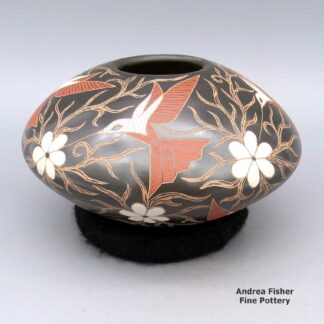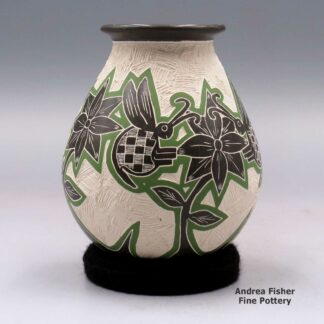Flower World
About the Flower World Complex
The Flower World Complex is an ideology based around a paradise filled with brilliant birds, brightly-colored butterflies, lush vegetation with plenty of precipitation and plentiful wildlife. The ideology of the Flower World Complex was particularly enticing to the people of the Southwest deserts and mountains as it promised something of wonder that they didn't have in their daily lives. But only if one obeyed all the rules issued by the local cacique could one get there. It was because the residents of the villages of Sikyátki and Awatovi stretched those religious boundaries that other Hopi villages destroyed them so long ago.
The Flower World ideology came together in central Mexico, designs have been traced to Teotihuacan. From there it migrated west, then north to Casas Grandes and Paquimé. It first appears in the American Southwest in the Mimbres region in the 1100s. By the 1200s it had migrated across Chaco Canyon to the Kayenta Anasazi and the Four Corners area. It is suspected that the arrival of the Flower World Complex with its new textiles, designs, rituals and ideology was responsible for the formation of the Kachina religion. In the latter decades of the 1200s, the Four Corners and Mesa Verde areas were depopulated, spreading those new developments across the Southwest from the Little Colorado River to Pecos, Gran Quivira and Acoma.
This proliferation may have been aided by a massive volcanic eruption on the other side of the planet at Mount Samalas in Indonesia in 1257 CE. Ash filled the sky around the globe for months and when it rained, it poured. Then the temperature dropped and the rain stopped. Crops either failed or were washed away, for several years. That eruption has been called the beginning of the Little Ice Age. For a religion that was primarily based on worship of the sun, the rain and the Three Sisters (maize, squash and beans), it must have looked like an epic fail. There is evidence that as people left the Four Corners and Mesa Verde areas, they slowly shed the accoutrements of the old religion and donned the regalia of the new one. Within a couple hundred years they had traveled up to several hundred miles to the east, south and west, and fractured into numerous different peoples speaking several different tongues as their ceremonies also diverged.
It has also been proposed that many images from the Flower World (flowers, birds, butterflies) brought a feminine principle back into what was then an increasingly male-dominated religion and society. Many of those images have been combined with imagery from before: the clouds, mountains, forests, wildlife, lightning bolts and such that add "depth" to the overall images.
The symbols and designs of the Flower World Complex are still being painted, etched and carved in today's pueblos, although their meanings have evolved over the years. Some of those designs were also easily translated into rock art and that art proliferated across the Southwest, changing the character of rock art everywhere between the Grand Canyon, the Arkansas River, the Pecos River and the Gulf of Cortez in only a couple generations.
Showing all 2 results
-

Elicena Cota, zzcg2j320m3, Polychrome jar with hummingbird, flower and branch design
$275.00 Add to cart -

Octavio Silveira, zzcg2f333m2, Polychrome jar with flared lip and a sgraffito and slipped bee and flower design
$195.00 Add to cart
Showing all 2 results